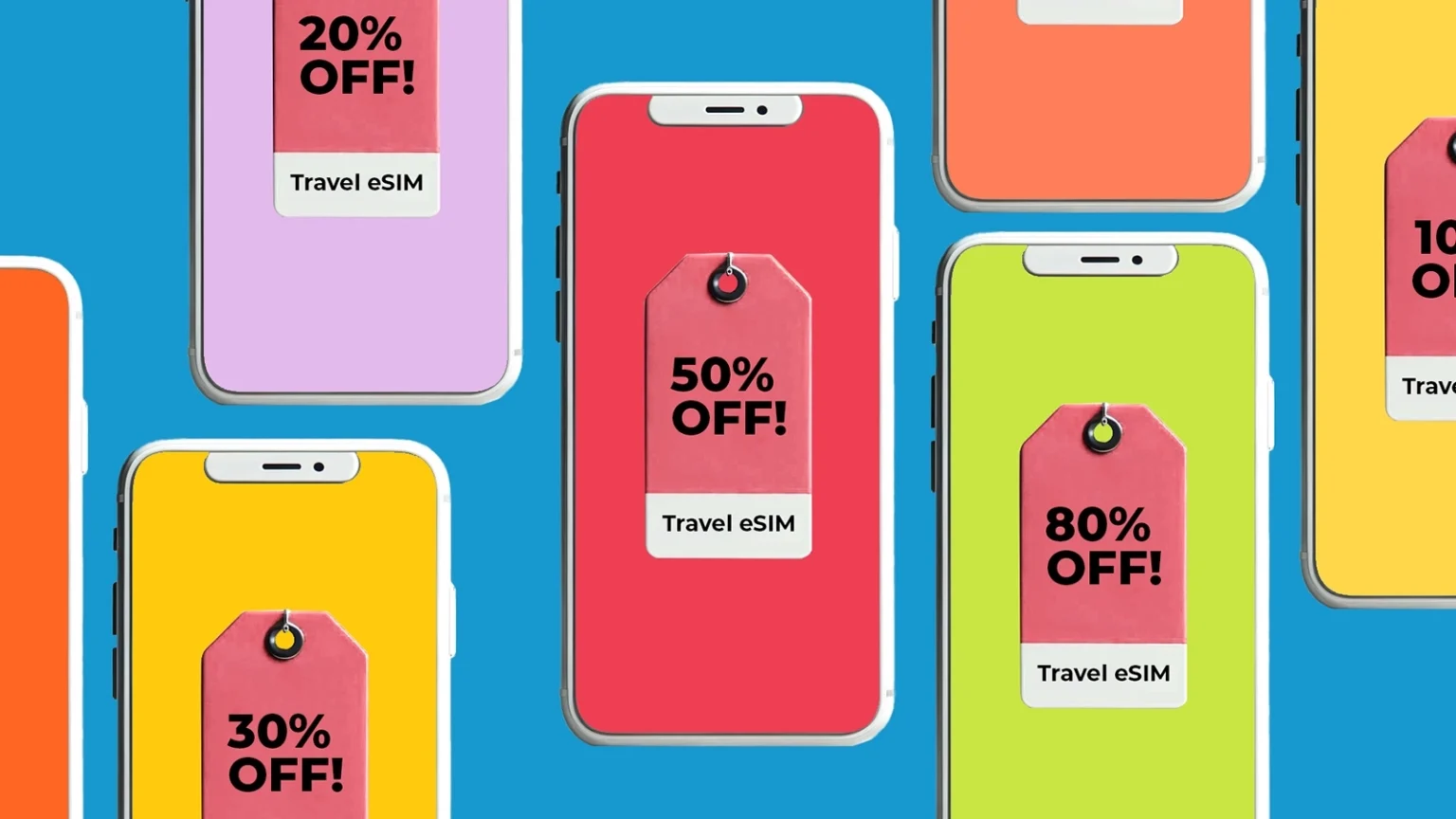eSIM, short for Embedded Subscriber Identity Module, marks a structural evolution in how mobile connectivity is configured, activated, and managed.
Unlike traditional SIM cards that require physical insertion, an eSIM is embedded directly into the device’s motherboard, allowing remote provisioning of carrier profiles without user intervention. Governed by GSMA specifications, eSIM technology has become pivotal in enabling digital onboarding, multi-network flexibility, and seamless switching across telecom operators.
The shift to eSIM parallels the broader trend of dematerialization in consumer electronics — reducing reliance on physical components while enhancing interoperability and user control. Central to this transformation is the eUICC (Embedded Universal Integrated Circuit Card) standard, which ensures secure and dynamic management of mobile identities across devices.
As telecom operators accelerate eSIM rollout (Check out verified eSIM Deals), OEMs are embedding it across smartphones, wearables, laptops, automotive modules, and industrial IoT systems.
Global eSIM Market Overview
Global eSIM Connections: Year-Wise Growth
The global eSIM market has expanded rapidly over the last 5 years, driven by device proliferation and growing operator readiness. The estimated number of eSIM-enabled consumer and IoT connections crossed 1.2 billion in 2023, with forecasts pushing this to 3.5 billion by 2027.
| Year | Estimated Global eSIM Connections |
|---|---|
| 2020 | 460 million |
| 2021 | 640 million |
| 2022 | 910 million |
| 2023 | 1.2 billion |
| 2024 | 1.7 billion (projected) |
| 2025 | 2.3 billion (projected) |
| 2027 | 3.5 billion (projected) |
Adoption Acceleration: eSIM vs Physical SIM
While traditional SIM cards still dominate low-tier and legacy mobile segments, the pace of eSIM adoption has outstripped projections. Flagship smartphones now arrive with eSIM-only variants in many regions. Apple triggered this shift by removing the SIM tray entirely in several iPhone 14 models across the US.
The eSIM attachment rate — defined as the % of devices sold with active eSIM usage — moved from 19% in 2021 to nearly 28% in 2023 globally. This trend is being accelerated by travel eSIM services, dual-SIM preference, and roaming convenience.
Revenue & Market Size Projections
By the end of 2024, the global eSIM market is projected to surpass $7.3 billion in value. This includes:
- Consumer smartphone & wearable segment: $3.6 billion
- IoT & M2M segment: $2.4 billion
- Enterprise & B2B integrations: $1.3 billion
Compound annual growth rate (CAGR) is expected to average 16.8% from 2023 to 2030, with momentum strongest in Asia Pacific and North America.
Device-Level Adoption Statistics
eSIM is no longer limited to premium smartphones. It has become a foundational technology across multiple connected device ecosystems. This section segments eSIM integration by hardware vertical.
Smartphones with eSIM: Brand & OS Distribution
Apple led the consumer adoption curve, introducing eSIM in iPhone XS and expanding to eSIM-only models in the US by iPhone 14. Google followed with eSIM in Pixel 2, and Samsung gradually rolled out support in its flagship Galaxy series. As of 2024:
| Brand | eSIM Support Models | Market Share in eSIM Smartphone Segment |
|---|---|---|
| Apple | iPhone XS onward | 48% |
| Samsung | Galaxy S20 onward | 24% |
| Pixel 2 onward | 11% | |
| Motorola | Select G & Edge | 7% |
| Huawei | P40, Mate 40 series | 5% |
| Others | Varies | 5% |
The percentage of all smartphones shipped with eSIM support reached 36% globally in 2023, projected to cross 50% by 2025.
eSIM in Wearables, Tablets & Laptops
Wearables, especially LTE smartwatches, are becoming a major growth engine for eSIM. The Apple Watch Series 3 Cellular introduced eSIM in smartwatches, and since then:
- 72% of all LTE-enabled smartwatches in 2023 shipped with eSIM
- iPads and Galaxy Tabs also feature eSIM in premium variants
- Microsoft Surface Pro X and Lenovo ThinkPad X1 are leading eSIM-ready laptops
By 2025, over 130 million laptops are expected to support eSIM, largely driven by enterprise deployments.
eSIM in Automotive & Connected Vehicles
Automotive OEMs are embedding eSIMs into vehicle telematics units for always-on connectivity, over-the-air updates, infotainment, and V2X communications. Key stats:
- 58% of new connected cars in North America supported eSIM in 2023
- Europe reached 41%, driven by EU eCall mandates
- Global automotive eSIM shipments expected to hit 214 million units by 2025
Major adopters include Tesla, BMW, Mercedes-Benz, Toyota, and Hyundai.
eSIM in Industrial IoT
Industrial IoT and M2M segments are utilizing eSIMs for:
- Logistics asset tracking
- Smart agriculture
- Remote surveillance
- Utility meters
- Wearable medical devices
The eSIM share in IoT modules rose from 11% in 2020 to 27% in 2023. By 2027, it’s projected that over 1.2 billion active IoT devices will run on eSIM.
Geographic Breakdown: Regional & Country-Level Insights
Adoption of eSIM varies significantly across regions, based on operator support, regulatory readiness, consumer education, and OEM focus.
North America
North America leads the world in eSIM penetration for consumer devices.
- 64% of new smartphones in the US supported eSIM in 2023
- eSIM-only iPhones are now mainstream in US market
- Canada has 3 of the Big 4 carriers fully supporting eSIM
The consumer awareness of eSIM is highest here, with widespread usage in travel, roaming, and dual-line management.
Europe
Europe has been a strong growth region due to:
- Early GSMA alignment
- eCall regulation in automotive
- High operator competition
Key countries:
- Germany: 52% smartphone eSIM readiness
- UK: Strong travel eSIM usage
- France: Rapid wearable eSIM adoption
By 2025, Europe is expected to cross 800 million eSIM-enabled connections across all verticals.
Asia Pacific
Asia Pacific is the most fragmented market — with rapid adoption in tech-forward nations and slow progress in price-sensitive regions.
- Japan, South Korea & Singapore are eSIM-mature
- India is accelerating post Jio & Airtel eSIM support
- China has proprietary eSIM policies restricting cross-OEM portability
Projected CAGR is highest in this region — nearly 21.3% between 2023 and 2027.
Middle East & Africa
Adoption is at an early stage but growing due to:
- International travel SIM demand
- New MVNOs launching eSIM-only offerings
- OEM push through mid-range devices
UAE and Saudi Arabia are leading in consumer eSIM activation among GCC nations.
Latin America
Challenges include limited operator support and price sensitivity.
- Brazil, Mexico & Argentina are the top 3 markets
- Travel and tourism boost temporary eSIM use
- Enterprise IoT eSIM use cases are rising
Market readiness remains medium to low, but growth prospects are positive as MNOs expand coverage.
Consumer vs M2M eSIM Distribution
eSIM adoption follows two macro segments: consumer applications (smartphones, wearables, tablets) and M2M or machine-to-machine applications (IoT modules, industrial sensors, fleet management, smart meters). Each segment exhibits distinct growth curves, use cases, and technical demands.
Consumer Segment Growth
By 2023, over 820 million consumer devices globally had active eSIM profiles. Smartphones led the charge, but wearables contributed 27% of active eSIMs in the consumer category. Key drivers include:
- Dual SIM utility for personal and work numbers
- Simplified switching between networks without changing hardware
- Roaming convenience for international travel
- Increasing support from flagship and mid-tier devices
Projected share of consumer eSIM connections by 2027 is expected to reach 2.6 billion globally.
M2M & Industrial Segment
Industrial IoT and M2M connections form the backbone of the eSIM surge in logistics, smart agriculture, connected utilities, and enterprise-grade field assets.
- By 2023, 420 million active M2M devices had eSIM integration
- Logistics & asset tracking contribute 32% of this base
- Smart energy meters and connected health devices account for another 29%
M2M eSIMs rely heavily on remote provisioning, multi-network profiles, and high durability. Growth is infrastructure-led, supported by 5G rollout and private cellular networks.
Carrier & Telecom Operator Statistics
eSIM growth is directly correlated with telecom operator readiness. Globally, over 300 mobile network operators (MNOs) support eSIM provisioning across 100+ countries.
Global Operator Readiness
| Region | No. of eSIM-Ready Operators | Notable Carriers |
|---|---|---|
| North America | 34 | AT&T, Verizon, T-Mobile, Rogers |
| Europe | 82 | Vodafone, Orange, Telefónica, EE |
| Asia Pacific | 67 | Jio, Airtel, SoftBank, Optus |
| Middle East | 29 | STC, Etisalat, Ooredoo |
| Latin America | 24 | Claro, Vivo, Movistar |
| Africa | 17 | MTN, Orange Africa, Telkom |
Telecom Adoption Metrics
- Activation Success Rate: 93% in eSIM-ready countries
- Average Profile Download Time: 8 seconds (2023 benchmark)
- Consumer Awareness Campaigns Launched: 62 across 34 nations in the last 2 years
- Dual Profile Support Uptake: 36% of users activate 2 eSIM profiles concurrently
MNOs are increasingly investing in digital KYC, remote onboarding, and eSIM bundling with travel and roaming plans.
eSIM and Device OEM Ecosystem
OEMs play a central role in embedding eSIMs across devices. This includes chipset integration, form factor miniaturization, and alignment with GSMA eUICC standards.
Smartphone OEM Adoption
- Apple leads with full eSIM adoption across flagship and entry-level SKUs in the US.
- Google Pixel lineup is 100% eSIM-enabled since Pixel 3.
- Samsung offers eSIM across Galaxy S, Z Fold, Flip, and Watch series.
By 2025, 52% of all smartphones shipped are expected to carry eSIM support.
Wearables, Laptops, Tablets
| Device Type | Notable OEMs |
|---|---|
| Smartwatch | Apple, Samsung, Huawei, Oppo, Garmin |
| Laptop | Lenovo, HP, Microsoft, Dell, Acer |
| Tablet | Apple (iPad), Samsung (Galaxy Tab), Microsoft Surface |
Enterprise demand for always-on connectivity is pushing OEMs to pre-embed eSIM across mobile computing categories.
Chipset Manufacturers
Key chipset players in the eSIM value chain include:
- Qualcomm: Integrated eSIM solutions with Snapdragon
- STMicroelectronics: Industrial eSIM modules
- NXP: Secure elements with automotive-grade resilience
- MediaTek: eSIM integration in mid-tier smartphones
These players support mass adoption by ensuring carrier compatibility, embedded encryption, and low-power operation.
Consumer Behavior and eSIM Usage Trends
Understanding user behavior around eSIM activation offers insight into adoption velocity and friction points.
Demographic Patterns
- Age 18 to 34: Highest adoption group at 53%
- Age 35 to 49: 27%, driven by dual-SIM productivity needs
- Age 50+: 20%, slower uptake due to limited awareness
Urban populations account for 71% of all active eSIMs, highlighting an education gap in semi-urban and rural zones.
eSIM Usage Patterns
| Behavior Type | % Share (2023) |
|---|---|
| Primary SIM replacement | 38% |
| Secondary (dual SIM) use | 45% |
| Roaming/travel specific | 17% |
eSIM Activation Preferences
- 64% of users activated eSIM using QR code method
- 22% used app-based provisioning (e.g., through carrier apps)
- 14% were activated via pre-installed carrier profiles (especially in wearables)
Key pain points include profile switching limitations, lack of operator interoperability, and limited prepaid support.
eSIM in Travel & Roaming Segments
eSIM has transformed how users manage connectivity across borders. Roaming and travel use cases now account for a significant share of first-time eSIM adoption.
Market Size & Growth
The global travel eSIM market is expected to cross $2.2 billion by 2025, up from $980 million in 2022. Adoption is highest among:
- Frequent travelers
- Digital nomads
- Tourists seeking short-term data plans
- Remote workers in cross-border zones
eSIM Roaming Benefits
- Instant access to local networks without physical SIM swaps
- Dynamic profile download across countries
- Elimination of SIM card costs & delivery logistics
Travel eSIM Behavior Statistics
| Metric | Value (2023) |
|---|---|
| Avg. number of profiles per user | 2.4 |
| Countries where eSIM used | 3.8 on average |
| Days before travel when activated | 3.1 days |
Top 10 Travel eSIM Brands (2024 Ranking)
- Airalo – Broadest global coverage with budget plans (Check Airalo eSIM deals)
- Nomad – eSIM packs for Asia, US & Europe
- Ubigi – Known for enterprise & automotive eSIMs
- GigSky – Popular in North America & Europe
- Holafly – High-speed data packages with unlimited plans
- Truphone – Strong in enterprise & multi-device offerings
- BNESIM – Global nomad-focused with smart routing
- KnowRoaming – Strong performance in Africa & Latin America
- Flexiroam – Premium roaming bundles
- YeSIM – Simplified setup & multi-profile support
These brands compete on country coverage, profile download speed, pricing flexibility, and ease of use.
Security, Privacy & Compliance Statistics
As digital identity shifts from physical SIM cards to remotely managed eSIM profiles, security becomes a foundational pillar. The eSIM ecosystem is secured through GSMA-compliant eUICC architecture, encrypted remote provisioning, and tamper-resistant chip design.
Remote SIM Provisioning (RSP) Security Metrics
- 100% of eSIMs use asymmetric key encryption during profile download
- 95% of eSIM-ready operators comply with GSMA SAS-SM (Subscription Manager) protocols
- Tamper resistance rating: FIPS 140-2 Level 3 or higher in enterprise-grade modules
Threat Landscape
- SIM swap attacks have reduced by 43% in eSIM-enabled networks due to lack of physical access
- Profile cloning is nearly impossible with embedded secure elements
- The most common user-level risk remains phishing during QR code provisioning
Compliance Readiness by Region
| Region | eSIM Privacy Framework Adoption (2023) |
|---|---|
| Europe | 94% (GDPR-aligned provisioning flows) |
| North America | 89% (CCPA, CPRA readiness) |
| Asia Pacific | 76% (fragmented by country) |
| Middle East | 62% (evolving, fast-tracking legislation) |
| Africa | 48% (lagging in enforcement) |
Carrier-grade security in eSIM is driving adoption in sensitive industries including healthcare, finance, and defense.
Sustainability & Environmental Impact
eSIMs contribute to sustainability by reducing plastic usage, shipping overhead, and e-waste generated by traditional SIM cards and packaging.
Lifecycle Environmental Benefits
- 80% reduction in plastic waste per user with eSIM-only models
- CO₂ emissions per SIM card lifecycle: Traditional SIM = 5.6 grams, eSIM = 0.8 grams
- Elimination of physical logistics reduces 42% of energy consumption in distribution networks
Manufacturing & Packaging Shift
- 1 billion SIM cards shipped physically in 2022 created 7,100 tons of plastic waste
- eSIM-only models are projected to reduce annual packaging waste by over 3,000 tons by 2025
Industry-Level Impact
- Telecom OEMs save an estimated $1.7 billion annually in logistics, warehousing, and material sourcing due to eSIM transition
- eSIM accelerates circular economy adoption by decoupling connectivity from hardware and packaging
Future Forecasts & Technological Developments
eSIM is evolving beyond standalone integration. The rise of iSIM, 5G standalone (SA), and satellite connectivity is reshaping the identity and authentication landscape.
eSIM vs iSIM
- iSIM integrates SIM functions directly into the device’s main SoC (system on chip)
- It reduces power consumption, lowers cost, and boosts security
- iSIM device shipments are expected to reach 300 million units by 2027
5G + eSIM Fusion
- 5G standalone requires dynamic network slicing, and eSIM enables faster provisioning
- Real-time QoS management becomes possible when SIM functions are software-driven
Satellite Connectivity
- Brands like Apple (Emergency SOS), Bullitt, and Huawei are leveraging satellite-eSIM bridges
- Next-gen eSIM profiles will support fallback switching between terrestrial and satellite networks
Connected Home & Health Devices
- Wearables, smart speakers, glucose monitors, and emergency alert systems are integrating eSIM to enable always-on connectivity
- By 2026, 41% of connected healthcare devices are projected to carry eSIM or iSIM modules
Challenges, Limitations & Industry Barriers
Despite growth, the eSIM landscape faces friction across technical, regulatory, and behavioral vectors.
Consumer Challenges
- Limited awareness: Only 38% of smartphone users know how to activate an eSIM
- QR code activation dependency restricts usability without dual screens or printouts
- Prepaid user onboarding is inconsistent across carriers
Carrier Limitations
- Not all operators support full remote provisioning or dual-profile switching
- Some OEMs restrict eSIM to postpaid or contract-based plans only
- Interoperability issues between carrier portals and device UIs
Regulatory Gaps
- SIM ownership rules in many countries are tied to physical documents
- Lack of national frameworks around eSIM profile portability
- Absence of fraud standards for app-based activation
Overcoming these gaps requires cohesive efforts between GSMA, OEMs, regulators, and carriers.
Strategic Opportunities for Stakeholders
As eSIM matures, ecosystem players can tap into new growth avenues.
For Device OEMs
- Expand mid-range device compatibility to unlock price-sensitive user segments
- Enable factory-provisioned eSIM bundles to reduce activation friction
- Integrate eSIM diagnostics into device settings for transparency
For Carriers
- Launch digital-only plans with instant eSIM provisioning
- Leverage eSIM for churn reduction via seamless porting and multi-line discounts
- Offer enterprise control panels for managing multiple eSIM profiles across devices
For Travel & Retail Brands
- Sell pre-provisioned eSIM QR codes for tourists at airports and hotels
- Bundle eSIM data packs with luggage, travel insurance, or digital concierge apps
- Partner with global MVNOs to offer country-specific data packs on-demand
The eSIM opportunity spans both product and service transformation layers.
Closing Thoughts
eSIM is not just a hardware evolution — it’s a redefinition of digital identity, device flexibility, and user control. With over 3 billion projected connections by 2027, it is fast becoming the new global standard in connectivity.
From connected cars to wrist-based glucose monitors, from airline check-ins to enterprise M2M provisioning, eSIM is unlocking new layers of mobility, efficiency, and scale. While friction points remain, the ecosystem has passed critical mass.
The next decade will be shaped by embedded connectivity — and eSIM will remain at the heart of this revolution.






